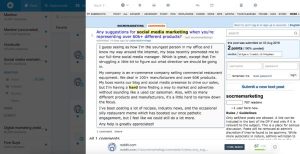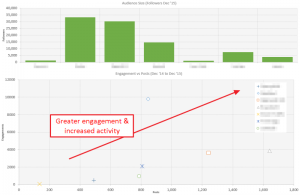How is it that some big companies are so bad at job satisfaction? It makes little sense.
If anything, big companies should understand the importance of job satisfaction since they have so many resources at their disposal.
A study by researchers at Baylor University found that employees of small businesses feel more loyal and committed than employees of big companies.

About 57% of employees at small companies had the highest level of commitment, compared to 40.5% of large company employees.
When you’re a scrappy startup, you have nothing to lose, so innovation and agility are your best weapons.
Startups will often test hundreds of things to try and find the perfect channel for them, in the hopes of hitting traction and taking off.
As a company grows, the mindset shifts from trying to achieve success to maintaining that success.
Once a company goes into “maintenance” mode, they become much less risky and innovative.
This can be a huge problem because instead of focusing on what motivates employees (personal growth), they’ll focus on not making any mistakes.
This is often referred to as “big company syndrome.” When things move so slowly, and you have to move through so many hoops to get anything done.
Not every large company goes through this, though.
We often mention Google on this blog, and for good reason. They’re one of the best examples of a large company that has managed to stay innovative and creative. It’s not by accident; they were very strategic about how they grew the company.

Things like 20% time helped keep them innovative and in that startup mentality.
When I wrote my post about having an agile culture, I talked about how Spotify stays agile as a big company. They separate all of their departments into mini-startups, each acting independently. It’s quite fascinating, and an interesting approach to staying lean as a large company.
All that to say, it is possible for a big company to be good at job satisfaction and avoid that big company syndrome, but they have to work very hard at it.
When you were younger, you were probably told that the smartest things for you to do would be to start your career in a big corporate environment, learn the good and the bad, and then go work for a startup and apply all of that knowledge.
Working in a large organization can be one of the most frustrating experiences, but obviously there are some positives, like larger budgets, potentially better perks, etc.
No matter if you’re a startup or a big company, everyone is concerned with how to improve employee engagement to make their company a great place to work.
Here are the main reasons why most big companies fail at job satisfaction:
- Too Much Bureaucracy
- Annual Performance Review Is Too Structured
- Lack Of Innovation
- No Career Development
- Shifting Priorities
- Too Risk Averse
- Management Problems (The Peter Principle)
- Bad People Aren’t Fired
- Frequent, Unproductive Meetings
- Feeling Like A Small Cog In A Big Machine
Let’s dive into each one of those reasons and explore the best ways to alleviate those problems while improving job satisfaction.
1. Too Much Bureaucracy
The classic “red tape.”
Every block in the process is yet another way to ruin innovation and more importantly, motivation.
As companies get more large and complex, there will be a need to manage all of that efficiently. There will also be a need for accountability across the organization, and bureaucracy helps with this.
The problem is, too often the number of rules and regulations become bloated (and unnecessary), inefficient and even wasteful.
It’s rare that the processes set up will be reviewed and optimized, which is a big mistake. Similar or identical tasks could be performed multiple times in an organization with too much bureaucracy.
If you need to ask for permission and get multiple levels of approval before each decision you make, you won’t be able to be as agile of a company.
How To Fix This:
Give employees the autonomy they deserve. Remove as much of that red tape as possible and make it easier for tasks to get done.
2. Annual Performance Review Is Too Structured
There are two outdated types of performance review structures that are still used by many large companies, but some are getting better at it.
Microsoft and Adobe are recent examples of companies that have gotten rid of these old-school approaches to evaluations.
The two performance assessment models to avoid are:
Rank-And-Yank
The term “rank-and-yank” is Jack Welch’s famous model for employee evaluation at GE. It’s known as a “20-70-10” system. The top 20% of the workforce is the most productive, and 70% are average.
The bottom 10% are the least productive and should be fired.

GE has seen massive success from this program, but I find it too dog-eat-dog. I don’t like that type of competition. It might work well for salespeople, but for other functions of a company, collaboration is a better idea.
Five-Point Scale
In an amazing article for Harvard Business Review, Patty McCord (co-author of the Netflix culture doc) says:
If you talk simply and honestly about performance on a regular basis, you can get good results—probably better ones than a company that grades everyone on a five-point scale.
Think about it—can a year’s worth of work be summarized by “meets expectations”? Employees aren’t getting the type of feedback they need.
How To Fix This:
Meet with employees regularly (monthly one-on-one’s are great) to give them the frequent coaching that they need. Ask employees to think about their performance and have them share their thoughts.
3. Lack Of Innovation
As companies get bigger, they focus more on risk-aversion than innovation. Also, the way most big companies are structured makes it harder for them to innovate.
With more layers of management, innovations become much tougher to execute on.
Most of a big company’s resources will need to be spent on the core business and sustaining their growth. The bigger the business, the bigger the needs are to maintain their growth.
I’ve discussed Spotify in the past, and how they use “squads” to continue to be innovative as a big company. The squads essentially split the company into smaller, independent teams.
Recently, Google announced they were creating a new parent company called Alphabet to organize better the company and to maintain that level of independence and innovation they’re used to.
Fundamentally, we believe this allows us more management scale, as we can run things independently that aren’t very related. – Larry Page
How To Fix This:
Look to big companies that stay innovative as examples. Companies like Google and Facebook regularly switch people’s desks, they use tools for collaboration, they encourage everyone to have ideas and speak up.
4. No Career Development
Many large companies struggle with this because of how complex the organization has become.
There are so many people doing so many things, that often just running the day-to-day operations and reducing that risk doesn’t lend itself to career growth and development.
Research has found that it’s all about employee perceptions.
Even when organizations provide programs to help employees develop their skills if employees perceive that career development opportunity is low, they are more likely to leave.
Companies need to find a way to give employees that opportunity for development. It’s not necessarily about promotions; it’s often just about getting better at what you do and exploring new skills.
Personal growth is even more important to us as getting a job promotion.
How To Fix This:
Set up a regularly scheduled event to discuss career development with each employee. Again, a monthly one-on-one with employees would be a great opportunity for this.
5. Shifting Priorities
We’ve all likely experienced this. Having your company constantly shift priorities can be incredibly frustrating.
One of the trickiest parts about getting employees engaged is getting them bought into the company’s mission and goal. If those goals keep changing, you’re making it much harder for someone to believe in them.
This happens more often in large companies because of how often things change, like a new CEO, new senior managers, new supervisors, etc.
How To Fix This:
The team needs to have a clear vision with clear milestones so everyone can get aligned around them. Objectives and Key Results (OKRs) is one of the best ways to align the team around shared goals.
6. Too Risk Averse
Large companies are often very risk-averse, for a few reasons.
The Legal Department
The idea of protecting yourself against a major lawsuit deters most companies from taking big risks.
Impact Of Failure
A big failure would naturally affect a lot more people in a large company. It’s one thing to take a giant risk when you have 50 customers versus 50,000 customers.

I can accept failure. Everybody fails at something. But I can’t accept not trying. Fear is an illusion. Michael Jordan, Basketball All-Star Player
Bystander Effect
It’s easier to assume that someone else will do the work when you’re in a company of 1,000 employees. That’s called the Bystander Effect. It’s a social psychological phenomenon that refers to cases in which individuals are less likely to take the lead if enough people are present.
The probability of taking action is inversely related to the number of bystanders.
Companies that embrace risk-taking and failure have been rewarded for it. One of the best examples of this is Google:
Google is known for YouTube, not Google Video Player. The thing is, people remember your hits more than your misses. It’s okay to fail as long as you learn from your mistakes and correct them fast. Trust me, we’ve failed plenty of times. Knowing that it’s okay to fail can free you up to take risks. And the tech industry is so dynamic that the moment you stop taking risks is the moment you get left behind.Susan Wojcicki
How To Fix This:
To start, set up a cross-functional “innovation lab” where new ideas can be tested easily. Understanding that innovation needs to occur and getting everyone in that mindset is step number one.
7. Management Problems (The Peter Principle)
For those that aren’t familiar, the Peter Principle is a concept where someone is promoted based on their performance in their current role rather than the skills needed for the new role.
The most common example is when a software developer that likes to code gets promoted to team leader, and now has to manage a team.
Maybe they’re not good at being a manager, but they’re amazing at programming.
The team suffers because they don’t have a good manager.
In time, every post tends to be occupied by an employee who is incompetent to carry out its duties -Laurence J. Peter (creator of the Peter Principle)
This happens more often in large companies, because of how hierarchical they are. Companies that embrace a flatter hierarchy will likely avoid a lot of these issues.
How To Fix This:
Don’t simply promote the person “next in line” for the job. Be willing and open to finding those quiet leaders that might be a better fit. Test for skills, not experience.
8. Bad People Aren’t Fired
There is a popular catchphrase in the startup community:
Hire slow, fire fast.
With that said, in large companies people get fired much slower.
There are two reasons for this:
- They blend in and go unnoticed
- Large companies are scared of wrongful termination suits
Blending in and going unnoticed is bad enough and a relatively easy problem to fix, but the issue of companies being scared of wrongful termination suits is just silly.
Both middle managers and HR are often in a tricky situation.
If HR wants someone to let go, but there’s not enough paperwork to warrant an employee being let go (written warnings, etc.) then there’s not much that can be done.
How To Fix This:
Fire people that don’t deserve to be there. If you’ve tried to help them, engage them, train them, etc. and nothing is working, let them go. They are ruining the company culture in more ways than one.
9. Frequent, Unproductive Meetings
In the book Getting Real by 37Signals, they sum up why meetings are so toxic:
Do you really need a meeting? Meetings usually arise when a concept isn’t clear enough. Instead of resorting to a meeting, try to simplify the concept so you can discuss it quickly via email or IM or Campfire. The goal is to avoid meetings. Every minute you avoid spending in a meeting is a minute you can get real work done instead.
We’ve all been victims of unproductive, useless “status update” meetings that have no agenda, drift off subject, or go way over time.
One of the best TED talks on the subject is by Jason Fried (from Basecamp):
How To Fix This:
Have fewer meetings. If you absolutely have to have a meeting, make sure to timebox it and have a clear agenda
10. Small Cog In A Big Machine
It can be very easy to feel like a small cog in a big machine when you work for a large company.
At a small startup, it’s easy to feel your impact on the company, but not so much when the company becomes so big.
Plus, the fact that there will likely be many people in the company that you never even see.
Very few things can be as demotivating as when you start to feel like you don’t matter, and they could easily get along without you.
How To Fix This:
Keep reminding employees of their purpose. Hammer that point home, employees need to feel connected to what they do and that their work matters. Tell employees often that they’re not a small cog and that you appreciate their work.
How To Improve Job Satisfaction
Whether you work for a small company or a big company, the importance of job satisfaction can’t be ignored.
The things needed to improve job satisfaction are all simple and free.
While it’s easier said than done, it is possible. And it’s worth the effort. The data is very clear about employees being satisfied and the link to productivity and profits.
Focus on the people in your organization, and make sure they’re having an incredible experience. Collecting feedback frequently from employees will help you understand what will make them more satisfied at work.
Things to focus on:
- Personal Growth
- Happiness (not to be confused with ‘engagement’)
- Company Alignment
- Frequent Recognition
- Friendships At Work
- Frequent Feedback
- Wellness
- Relationships With Managers
- Company Pride
- Job Satisfaction
These are the ten drivers of employee engagement. We go through them in detail in our eBook The 10 Essential Pillars Of Employee Engagement.
How Do You Measure Job Satisfaction?
Now that we’ve established that job satisfaction could be improved in numerous ways, it’s critical for companies to have an idea of where to invest their time and energy.
Most companies typically run an annual survey to measure job satisfaction, but a new trend is using employee pulse surveys to get a more frequent pulse on employee engagement.
Measuring more frequently is especially important for large companies that are typically slow to move. Tools like Officevibe can help you with this.
Any thoughts to share on job satisfaction in large companies?
It’s easy to get complacent when you’re in a large company, but employees still deserve to love their job.
These problems are relatively easy to fix, so there’s no reason why you shouldn’t be working to improve employee engagement.
Measuring employee engagement in real-time is an important part of making sure you’re addressing the right issues, and that you’re doing it as quickly as possible.
Now over to you, let me know your thoughts in the comments!
(262)
Report Post






